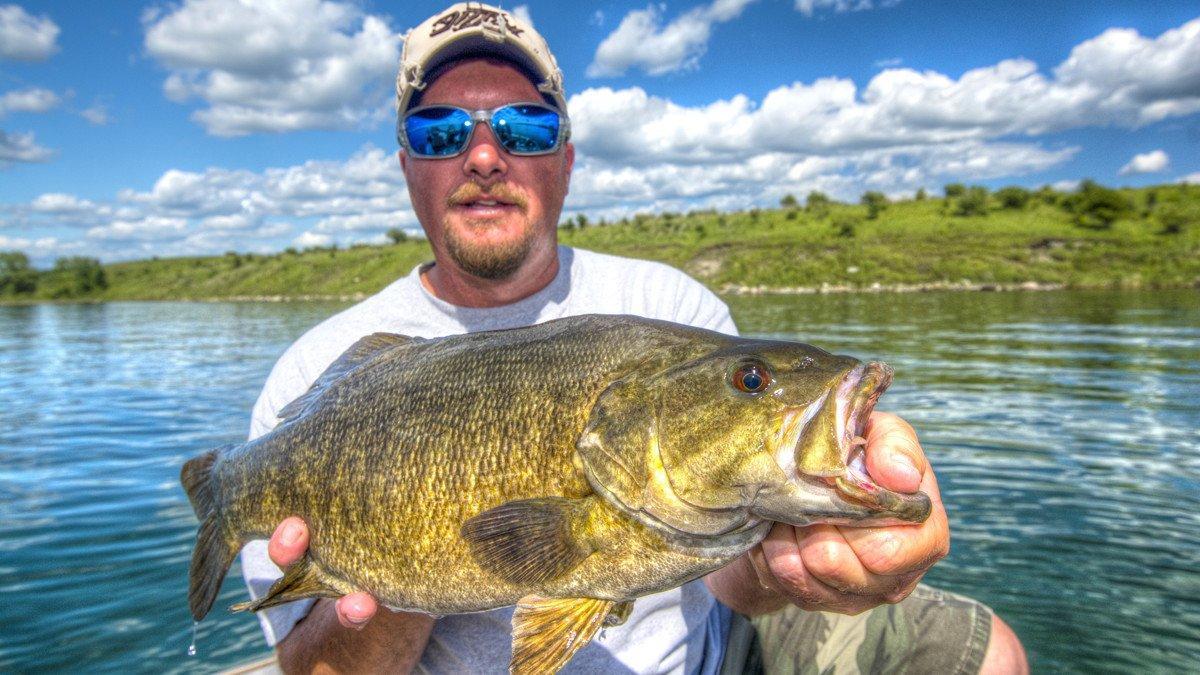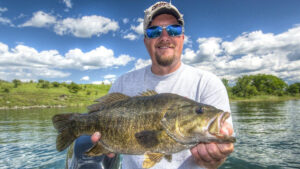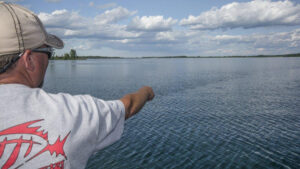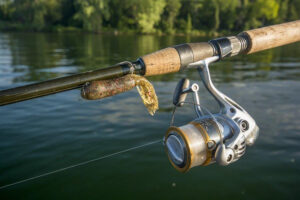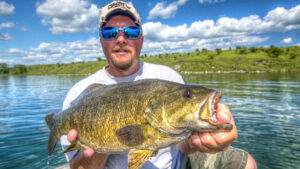Rivers are home to some of the best smallmouth bass fishing on the planet. The secret to consistently catching smallmouth from rivers is being comfortable fishing in current. This includes learning how to read a river, understanding the influence of current on smallmouth location and being able to effectively fish flowing water. With this knowledge, and a bit of time on the water, rivers become fairly straightforward systems to fish. If you’re not already targeting smallmouth in rivers, you need to start this season.
Ontario’s Jack Levert is a multi-species guide and competitive angler with more than 40-years experience catching smallmouth from the St. Lawrence River. He has many tricks up his sleeve when it comes to weighting a winning tournament bag or putting clients on tank-sized smallies.
The following are 5 of his fundamentals for catching big river smallmouth:
- Impact of current on bass location
- Current as a type of structure
- Read current to find “hard” structure
- Boat control is critical for river fishing
- Tackle tips for current smallmouth
CURRENT IMPACTS
Successful anglers understand how bass concentrate in specific areas in rivers as a result of current. Here are some ways to use this piece of the puzzle to your advantage.
“Most active smallmouth are going to be on the front or the top of the side of structure that’s facing into the current,” Levert said. “The resting or inactive fish are more likely going to be on the backside of the structure. But remember, we’re talking wild creatures here. This doesn’t happen all the time. I see it more like a 90-percent rule.”
- Target biters – Expect to find aggressive smallmouth on the current-facing side of reefs, bars, points, flats, islands and rock piles. Fishing these areas puts your bait around more potential biters than the downstream side of structure.
- Reading sonar data – Understanding smallmouth behavior in relation to current helps interpret the sonar screen. For example, when it displays fish present on the downstream side of a deep hump in main river channel, it’s a clue you may be up against neutral to inactive bass.
- Choosing baits – Use the knowledge of active and inactive bass positioning on structure to refine presentations. For instance, Levert will quickly fish a spinnerbait, Jackall Squad Minnow jerkbait or crankbait to cover water and catch active bass on the up-current side of structure. On the flip side, drop-shotting and finesse tactics are used to catch neutral or inactive smallies.
- The wildcards – “There are always exceptions to these patterns,” Levert said. “Baitfish and wind are two wildcards. Baitfish will pull active smallmouth off of structure, sometimes bass will suspend high in the water column if that’s where there’s baitfish. If it’s windy, feeding smallmouth may move to the wind-facing side of structure.”
CURRENT AS STRUCTURE
Levert considers current structure because of its strong influence on smallmouth location. Being dynamic, he refers to it as “soft” structure, compared to “hard” structures like rocks. In rivers, smallmouth relate to current edges as much as they do “hard” structure edges, such as sand-rock transitions. For Levert, the the proverbial icing on the cake is finding good current running over prime “hard” structure, such as a strip of broken rock or a grass covered sand bar.
A current seam, where fast and slow water intersect, is one of Levert’s favorite features. Depending on current speed, forage and other attributes, a smallmouth may use a seam as a feeding station or a resting area. Active smallmouth typically hold near or in fast flow. Resting ones are more often found in a seam of slower moving water.
Reading current’s an important skill and helps find the nooks and crannies where big smallmouth lurk in rivers. When learning new water, Levert recommends fishing when it’s windy. The breeze accentuates ripples on the water’s surface, making it easier to see current variations.
CURRENT EXPOSES REAL CONTOURS
Water always takes the path of least resistance, so when it changes direction, it’s because of an obstruction. Wing dams, boulders, reefs, bars and bridge pilings are common barriers. Following a current seam upstream can lead to “hard” structure lying beneath the surface.
To give an example, when fishing a flat Levert looks for current ripples to locate boulders, rocks or depth variations. These zones then become casting targets.
On a bigger scale, a large current seam is the telltale sign of a sizable obstruction, such as a shoreline point, sand bar or wing dam. These seams and associated “hard” structure are high percentage zones and concentrate smallmouth on an otherwise plain stretch of river.
BOAT CONTROL
“If you don’t have good boat position in current you’re loosing 80 percent of the battle, especially in fast current, like the St. Lawrence,” Levert said.
Levert’s view of boat placement’s as follows. An angler should position the boat to stay on prime water. Equally vital is maneuvering the boat to keep contact and control of the bait, which allows for a proper presentation and instant strike detection. Levert uses current and wind conditions to his advantage, but always stays in control using a bow-mount electric motor. He does this by following these 4 steps:
- Determine wind direction and speed
- Read current direction and speed
- Steer boat into whichever of the two (wind or current) is stronger
- Adjust electric motor thrust so the boat’s keeps an appropriate pace with the current and you keep contact with the bait
The last step’s the hardest one. To Levert maintaining contact with his bait trumps everything else, which means he matches tactics to boat speed. If wind and current force him to perform a fast, controlled drift, he fishes quickly. This could be burning a Jackall TN/70 lipless crankbait in shallow to mid depths, or power-finessing deep smallmouth with a heavily weighted drop-shot or tube.
TACKLE TIPS FOR STRONG CURRENT
Overall smallmouth bass are a hard fighting fish, but river bronzebacks often pull with extra gusto when compared to their lake counterparts.
“It’s like they’re on steroids,” Levert said. “They’re always working in the current. I think all the flow and oxygen in the water helps make them stronger, too.”
To battle big, powerful smallmouth, Levert recommends a rod, reel and line combination offering shock absorption. For instance, he frequently uses G. Loomis Walleye and Bronzeback 7-foot to 7-1/2-foot rods, which have a parabolic rod action through the upper half, but contain a strong backbone for leaning into fish.
“When you’ve got the hook buried in the roof of a smallie’s mouth, you’re going to land them on a stiff rod,” Levert said. “But when you’ve got them skin-hooked, or just stuck in the front lip, you need that parabolic action to cushion the fight and not rip out the hook.”
Levert also ups his line strength when chasing St. Lawrence giants. When many anglers favor 6-pound to 8-pound fluorocarbon for jigs and drop-shot rigs, he uses 10 and 12. He also uses PowerPro braid with a fluorocarbon leader.
If you’ve shied away from rivers in the past, give Levert’s 5 fundamentals a try and fish a river this summer. River smallmouth fight with the intensity of a title-defending champ backed into a corner. It’s certainly an angling experience not to be missed.
3 RIVER-SMALLMOUTHS COMBOS
- Lipless cranks – heavy-power crankbait rod or 7-foot, 1-inch medium-power, 7.2:1 or 6.3:1, 15-pound fluorocarbon.
- Tube jig – 7-foot, 4-inch medium-power, 2500 or 3000 spinning reel, 20-pound braid 12-pound to 15-pound fluorocarbon leader or straight 10-pound fluorocarbon.
- Drop shot – 7-foot, 6-inch light-power, 3000 spinning reel, braid with 10-pound fluorocarbon leader.


